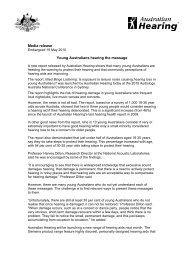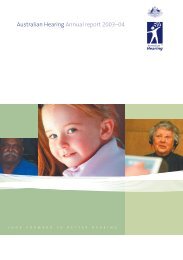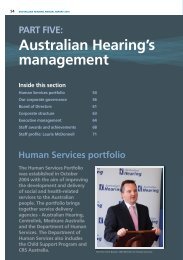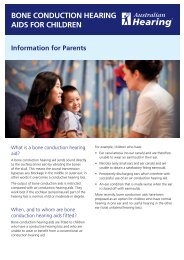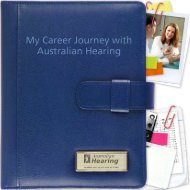to download PDF - Australian Hearing
to download PDF - Australian Hearing
to download PDF - Australian Hearing
Create successful ePaper yourself
Turn your PDF publications into a flip-book with our unique Google optimized e-Paper software.
severe <strong>to</strong> profound hearing loss may<br />
adjust within four weeks. It’s important<br />
<strong>to</strong> note that acclimatisation <strong>to</strong> sound<br />
(retraining the brain) can occur only if<br />
the hearing aids are worn for several<br />
hours on a daily basis. The more a<br />
hearing aid is worn, the faster one can<br />
adapt <strong>to</strong> new sounds. This is probably<br />
why people with severe <strong>to</strong> profound<br />
hearing loss, who need <strong>to</strong> wear their aids<br />
all day, take less time <strong>to</strong> acclimatise.<br />
How do I retrain my brain?<br />
It doesn’t matter whether you’re getting<br />
hearing aids for the first time or<br />
upgrading, you will still have <strong>to</strong><br />
acclimatise <strong>to</strong> the difference in speech<br />
and environmental sounds. The best<br />
place <strong>to</strong> do this is at home.<br />
Sit or walk around and listen with your<br />
hearing aids <strong>to</strong> all the sounds around your<br />
house. You can ask your audiologist for a<br />
Listening Check List <strong>to</strong> help you with this<br />
activity. Try <strong>to</strong> identify each sound.<br />
Do this every day until you can easily<br />
identify the sounds. Once they become<br />
familiar you’ll find them less and less<br />
intrusive until gradually your brain will<br />
ignore them and attend <strong>to</strong> more<br />
important sounds, such as the phone ring,<br />
the door-bell or a crash.<br />
Once you have developed the ability<br />
<strong>to</strong> cope with the environmental sounds<br />
around your home you will be less<br />
distracted by noise during social activities<br />
outside home. However, your brain can<br />
be retrained only if you wear your<br />
hearing aid for more than four hours<br />
each day around your home.<br />
Children or adults who are highly<br />
dependent upon their hearing aids can<br />
become very sensitive <strong>to</strong> changes in the<br />
signals they receive through them. They<br />
need <strong>to</strong> allow time <strong>to</strong> get used <strong>to</strong> the<br />
sound of a new hearing aid. They may<br />
not necessarily like how it sounds at first,<br />
even when the aid has features that<br />
should enhance speech understanding.<br />
That’s why it’s important <strong>to</strong> persevere<br />
with the hearing aids for several weeks in<br />
order <strong>to</strong> allow the brain enough time <strong>to</strong><br />
acclimatise <strong>to</strong> the new sound.<br />
A very young child fitted with hearing<br />
aids or a cochlear implant needs <strong>to</strong> learn<br />
the meaning of sounds, especially the<br />
ones that are essential for speech,<br />
language and communication. This is a<br />
much slower process and involves more<br />
than simply acclimatisation. Children<br />
need <strong>to</strong> wear their amplification device<br />
(hearing aids or an implant) most of their<br />
waking hours <strong>to</strong> learn <strong>to</strong> identify the<br />
variety of sounds in our environment.<br />
My voice sounds funny<br />
Some hearing impaired people wearing<br />
hearing aids for the first time find their<br />
voice sounds quite different, which can<br />
be disturbing. The reason is simple.<br />
When our hearing is normal, we are<br />
used <strong>to</strong> hearing our voice louder than<br />
other peoples’ voices. However, when<br />
you have a hearing impairment, you are<br />
hearing your voice at reduced volume.<br />
Once you have switched your hearing<br />
aids on, you’ll hear it again at normal<br />
volume and the brain will need <strong>to</strong> be<br />
retrained <strong>to</strong> adapt <strong>to</strong> the new volume<br />
level. A useful activity <strong>to</strong> help you adapt<br />
<strong>to</strong> your own voice is <strong>to</strong> read aloud <strong>to</strong><br />
yourself for five minutes each day in the<br />
first week or two after you are fitted<br />
with the hearing aid. Gradually you<br />
will be less distracted by the sound of<br />
your own voice.<br />
Patience and perseverance<br />
The aim of fitting hearing aids is <strong>to</strong><br />
improve your ability <strong>to</strong> hear in listening<br />
situations that are important <strong>to</strong> you.<br />
Remember that hearing aids are hearing<br />
aids and <strong>to</strong> achieve good communication<br />
you’ll need <strong>to</strong> persevere and retrain your<br />
brain <strong>to</strong> discard less intrusive sounds. By<br />
consistently wearing your hearing aids<br />
and practising listening in different<br />
situations between your fitting and<br />
review appointment, you will assist the<br />
audiologist <strong>to</strong> decide whether any real<br />
adjustments are required <strong>to</strong> make your<br />
hearing aids even better.<br />
Hear&Now 5




